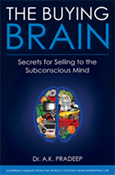Book Review: The Buying Brain: Secrets for Selling to the Subconscious Mind
By Julie King | October 3, 2011

| Title: | The Buying Brain: Secrets for Selling to the Subconscious Mind |
| Author: | Dr. A.K. Pradeep |
| Publisher: | John Wiley & Sons, Inc. |
| ISBN: | 978-0-470-60177-8-52795 |
Scenario: You spend thousands on an advertising campaign. Its catchy stuff, a mix of aggressive print and web ads that use fear to sell a healthcare service aging boomers.
Your business has a lot invested the campaign, but the ads fail to generate the response you expected. Was it bad timing? A product misaligned with its market? The wrong distribution channels?
Or was it something much simpler: Did your ads fail because they used an approach that simply would not engage your target audience?
Brain research is a fascinating science that is helping us understand the things that truly motivate customers. Findings show that the human mind is not a static or homogeneous. While we are similar in many ways, we have important differences.
Male and female brains typically respond to very different things. And the aging brain of a baby boomer differs from that of a younger person. Brain research could have helped the business in the scenario above predict that a fear-based ad campaign would fail.
When researchers tested the response of people to both positive and negative input, they discovered that for older people, the part of the brain that handles primitive emotions like fear, anger and happiness was not active when the input was negative.
The fear-based campaign targeting baby boomers was designed to fail.
Pradeep explores these differences, as well as the fundamentals of the mechanics of the mind, in Part 1 of his book, The Buying Brain. This is done in plain language, with a layout that makes it easy to scan for information.
Noting that women control 80 per cent of discretionary spending in the United States, Pradeep dedicates two full chapters – The Female Brain is Buying and The Mommy Brain is Buying – to the explore unique aspects of the female brain.
It is fascinating information – and very useful information for businesses and marketers alike.
Yet what really make this book worthwhile is the connections Pradeep makes the second half of his book, where he outlines a systematic process that can be use coupled with our emerging understanding of brain science to create truly effective advertising campaigns and consumer engagement.
For example, he outlines a "Total Consumer Experience (TCE)" framework that can be used to isolate points of a customer's experience when interacting with a product that are highly evocative for the brain and explains how this information can be used to "prime" consumers to desire and seek out your product between uses.
One drawback of some of the strategies in Pradeep's book is that some of the "neurometrics" he recommends – like TCE studies or his company's "Deep Subconscious Response" methodology – would be too costly for a small business to use.
With that being said, Pradeep does provide a great deal of information that can be used by almost any business to improve its marketing and advertisements.
Even if you only pick up a few ideas from The Buying Brain, whether it's how to market to women consumers or specific strategies that will help you create effective advertisements, The Buying Brain is a worthwhile read and gets a CanadaOne "Must Read" rating.






